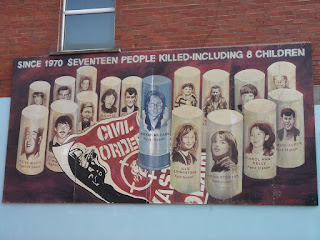Emerald Isle Part IV: Murals of Belfast and International Peace Line, Northern Ireland
Blind to religion or ancestry, the issue of gentrification may affect all sides of the Conflict...
Graffiti in Belfast, N. Ireland.
My one photo of the Shankill Road community, where Protestant Loyalists hold court, especially leading up to Orangemen's Day, observed on July 12. I visited Belfast during 'marching season', the week before this national holiday, a time when tensions are at their height between Protestant Loyalists and Catholic Republicans. Northern Irish Protestants celebrate William the Orange's defeat of King James II in the 1690 Battle of the Boyne, a battle that solidified the 6 county-Protestant rule of Northern Ireland. You will notice a mural celebrating the Shankill Protestant Forces, and many Union jack flags flying in the streets and along residences and storefronts.
One evocative mural along the International Peace Line, a 15 foot tall, barbed-wire frosted concrete tetris of walls that is currently at its longest length since the Conflict / the Troubles began in the 1960s. The walls cut through backyards and side streets to separate fourteen Loyalist and Republican communities from being able to access one another directly. The Dalai Lama planted one tree on each side of the Peace Line a couple years ago to plant the literal and figurative hope for the future generations of Northern Irish. I must say that this gray and vacant no-man's land in the crossing from Shankill Road (Protestant Loyalist area) to Falls Road (Catholic Republican area) felt eerie and heavy with distrust.
Memorial with Irish Republican graves. My Belfast political mural tour guide, Tomas, was an ex-IRA prisoner himself, having been released as a result of the Good Friday Belfast Peace Agreement. Tomas' father was killed during his service with the IRA, and he showed me where his body lay in this very cemetary.
An open field where thousands of poor, starved victims of the Hunger (also known as the Famine) were piled in a mass grave during the 1800s. The crazy part is that Ireland's rich landlords were exporting food during a time when its people were dying in droves.
Tomas told me about every mural we visited in the Falls Road neighborhood, where Irish promote their struggle against British occupation through art. This mural talks about Pat Finucane, who was killed while working as a human rights lawyer defending IRA political prisoners.
This mural remembers the 17 Irish people killed by British rubber bullets since 1970.
Bobby Sands is a very key figure in the struggle for Northern Irish independence. He was the first IRA prisoner to die from a hunger strike. His face is featured on several murals and all throughout the Falls Road community.
A community center dedicated to supporting ex-IRA prisoners and their families.
A Garden of Remembrance for Irish freedom fighters and innocent civilians killed in the Conflict.
Frederick Douglass worked with the Northern Irish against the British occupation after he helped gain the freedom of black slaves in the United States. He was apparently shocked upon arriving in Northern Ireland to see the subjugation and discrimination of Protestants against Catholics, as they would have both been part of the ruling white caste in the US.
Some key images from the Conflict. The tabloid on the left is of Margaret Thatcher, then Prime Minister of Great Britain, who refused to talk with the IRA because of their classification as a terrorist organization, thereby allowing 12 prisoners to die while on hunger strike.
The mural on the left illustrates the solidarity between Palestinians and native Irish, both of whom have struggled for freedom against occupation.
The mural on the left is a rendering of Picasso's Guernica, showing the brutality of war. The mural on the right features some iconic martyrs of the Irish fight for freedom.
The mural on the left demonstrates the connections between the Irish struggle against persecution and the struggles of blacks in Arkansas and the current racial/immigrant backlash in Belfast/Northern Ireland. I really appreciated the cross-connections that Republicans make with other movements around the world.
The final political murals here (not that this has been an exhaustive photo display of the murals of Belfast) show the Basque struggle for independence on the left and the Cuban revolutionary struggle on the right. In smaller letters below Che Guevarra's face, the artist asks Obama to lift the embargo on Cuba.



















wow holly, thanks for putting this up and taking the time to explain everything you saw!
ReplyDeletelove you and will call tomorrow!
Holly, what a fascinating tour! I bet you're exhausted. I'm sure you did some grounding exercises before that tour :) Hope you're feeling well. xoxo
ReplyDelete